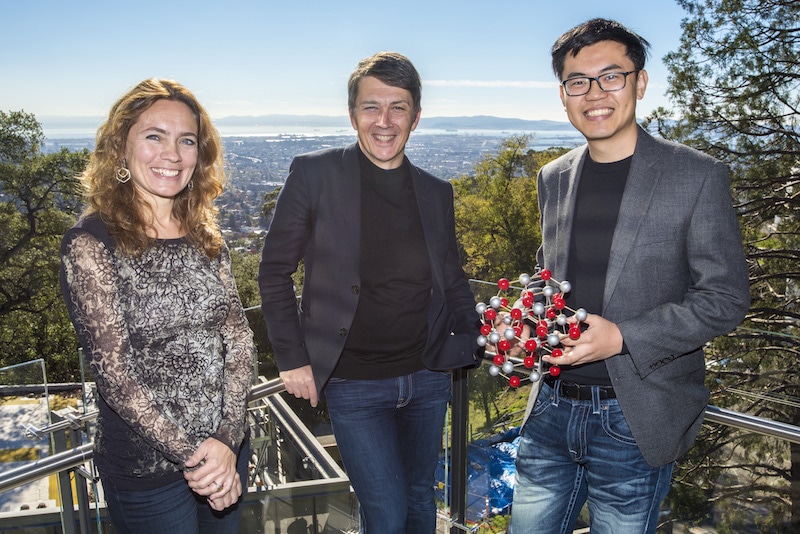Nov 21 2016
They say diamonds are forever, but in fact they are a metastable form of carbon that will slowly and ultimately transform into another form of carbon, graphite. It would be of great potential if materials designers could design and synthesize other long-lasting, thermodynamically metastable materials. However, this has yet to become a reality due to the lack of rational understanding of them.
 Berkeley Lab researchers (from left) Kristin Persson, Gerbrand Ceder and Wenhao Sun used the Materials Project to achieve a new understanding of metastable materials. (Credit: Marilyn Chung/Berkeley Lab)
Berkeley Lab researchers (from left) Kristin Persson, Gerbrand Ceder and Wenhao Sun used the Materials Project to achieve a new understanding of metastable materials. (Credit: Marilyn Chung/Berkeley Lab)
Recently, a team of researchers at the Department of Energy’s Lawrence Berkeley National Laboratory (Berkeley Lab) have published a new research paper that, for the first time, clearly quantifies the thermodynamic scale of metastability for approximately 30,000 known materials. This would facilitate the way for designing and creating promising next-generation materials for use in all industries spanning from steels to semiconductors to pharmaceuticals.
There’s a great amount of possibility in the space of metastable materials, but when experimentalists go to the lab to make them, the process is very heuristic—it’s trial and error. What we’ve done in this research is to understand the metastable phases that have been made, so that we can better understand which metastable phases can be made.
Berkeley Lab researcher Wenhao Sun
The research was published recently Science Advances journal in a paper titled, “The Thermodynamic Scale of Inorganic Crystalline Metastability.” Sun, a postdoctoral fellow working with Gerbrand Ceder in Berkeley Lab’s Materials Sciences Division, was the lead author, and Ceder was the corresponding author.
The research involved mass data mining of the Materials Project, which is a Google-like database of materials that uses supercomputers to measure properties according to the first-principles quantum-mechanical frameworks. The Materials Project, directed by Berkeley Lab researcher Kristin Persson, who was also a co-author of the new paper, has measured properties of over 67,000 known and predicted materials with the aim of speeding up materials discovery and innovation.
Materials design and development is truly a slow process but is now being greatly accelerated by the fact that we can compute properties of compounds before they are made. Although we still don’t fully understand which materials can be made and how, mapping the underlying thermodynamics is an important first step.
Ceder
Bridging a gap in the fundamental paradigm of materials science
Metastable materials, or materials that change to another state over an extended period of time, are ubiquitous in both technology and nature and frequently possess excellent properties.
Chocolate, for instance, is metastable, with better texture and a lower melting point than stable chocolate. There are also metastable steels that have both strength and toughness, properties not usually found simultaneously in a majority of stable steels.
Scientists would love to create new materials with specific properties for a variety of applications—an ultra-strong yet lightweight metal for vehicles, for instance—but to develop any new material with preferred properties, materials scientists will have to understand how synthesizing the material impacts its structure, and then how the structure consecutively affects its performance and properties. This, Sun explains, is the primary paradigm of materials science.
“The Materials Project has helped us link a material’s structure to its properties,” Ceder said. “What we’ve done here is the first quantitative step in understanding synthesis-structure relationships.”
Sun offers an analogy to food: “If the Materials Project were a cookbook, it’d be like a database of ingredients and delicious dishes but no recipes. Designing recipes is difficult because scientists have a poor understanding of why metastable phases appear during ‘cooking.’ There are some applications where a metastable material is better, and others where the stable phases are better. This study sets a foundation to investigate how to use computers to predict recipes.”
Proposing a new principle of metastability
Earlier, researchers only had thermodynamic numbers for about 1,000 metastable compounds. “It’s very hard to survey metastability over known materials because there’s not much data out there in terms of calorimetry, which is measuring thermodynamic numbers,” Sun said.
Furthermore, metastable materials are present in various forms, spanning metal alloys and minerals to salts, ceramics, and more, making a complete survey complicated. “What we’ve done is large-scale data mining on nearly 30,000 observed materials to explicitly measure the thermodynamic scale of metastability, as a function of a wide variety of parameters, like chemistry and composition, which inorganic chemists and materials scientists can use to build intuition,” Sun said.
Based on their observations, the researchers progressed a step further. They suggested a new theory they call “remnant metastability” to categorize metastable materials into those that can be synthesized and those that cannot. “We’re essentially proposing search criteriawe’re identifying which crystalline materials can be made, and possibly under what conditions they can be made,” Sun said. “We hope this can be a more refined way to think about which crystal structure nature chooses when a material forms.”
The other co-authors of the paper are: Anubhav Jain of Berkeley Lab, Stephen Dacek and William Richards of MIT, Shyue Ping Ong and Anthony Gamst of UC San Diego, and Geoffroy Hautier of the Université Catholique de Louvain in Belgium. The research was supported by the Materials Project and was a collaboration with the DOE’s Office of Science as part of its Center for Next Generation of Materials by Design, a DOE Energy Frontier Research Center. The researchers also used computing resources at the Center for Nanoscale Materials (CNM) at Argonne National Laboratory and well as resources at the Center for Functional Nanomaterials (CFN) at Brookhaven National Laboratory. CNM and CFN are DOE Office of Science User Facilities.